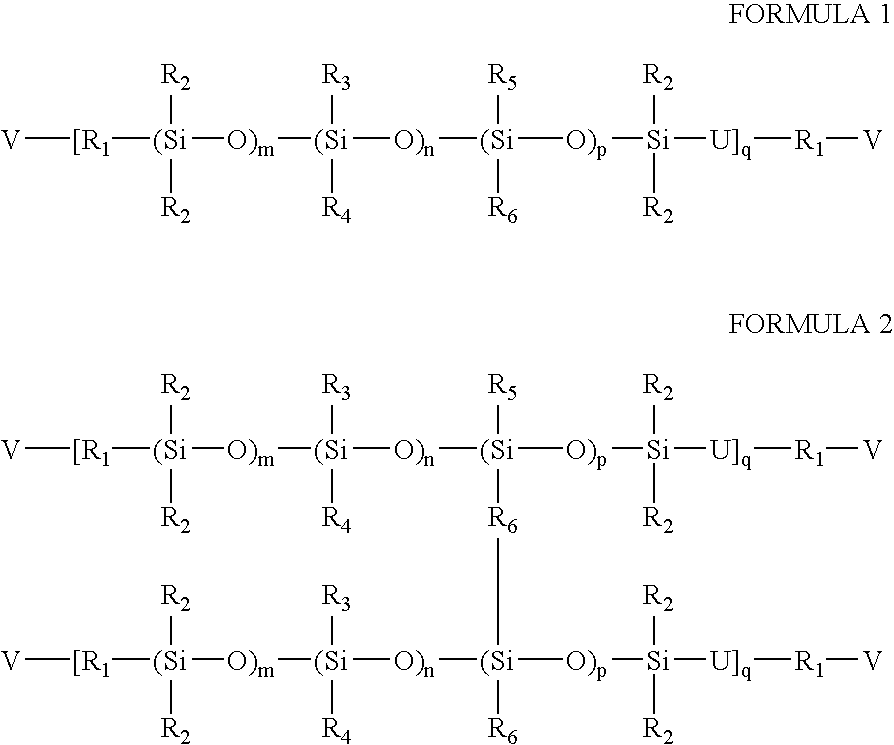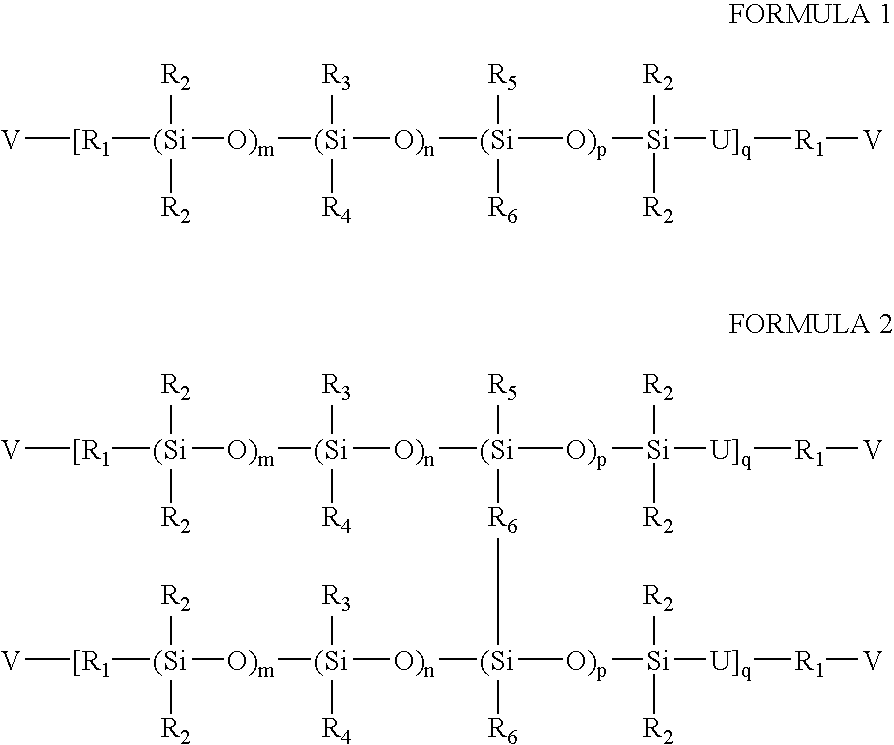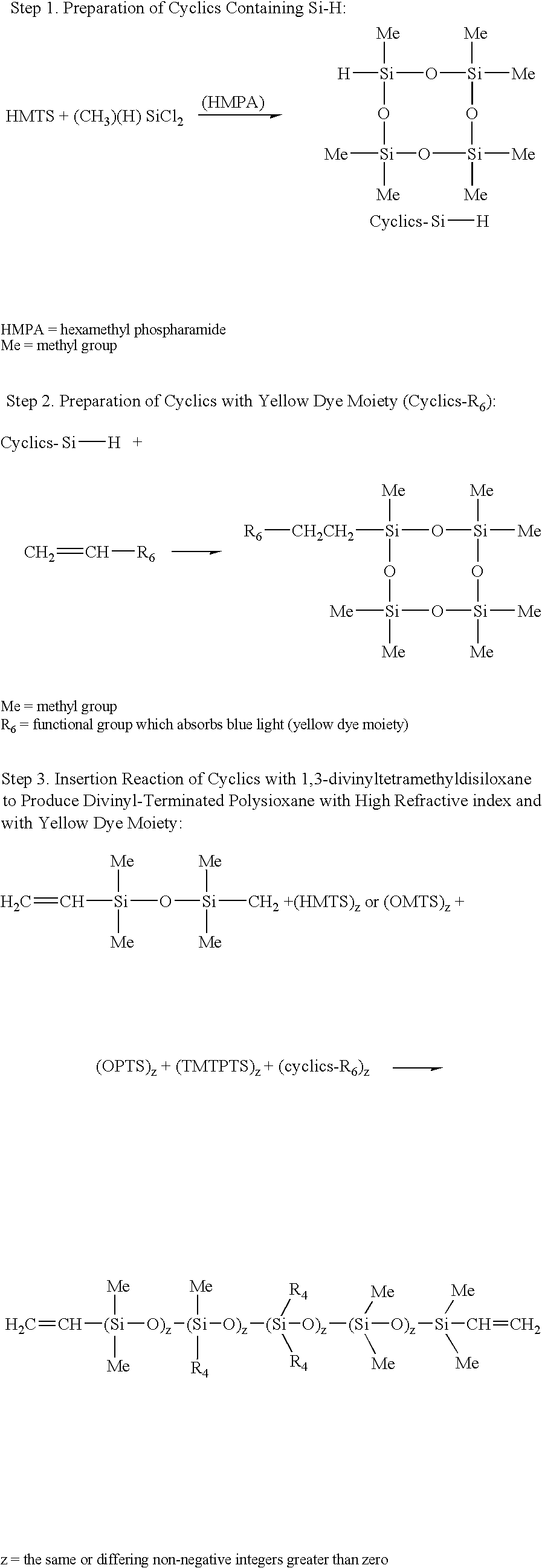High refractive index silicone-containing prepolymers with blue light absorption capability
a silicone and high refractive index technology, applied in the field of high refractive index siliconecontaining prepolymers, can solve the problems of blue light (400–500 nm) being recognized as potentially hazardous to the retina, less popularization of more rigid iol implants in the market, and increased incidence of postoperative bleeding, etc., to achieve good clarity and high refractive index
- Summary
- Abstract
- Description
- Claims
- Application Information
AI Technical Summary
Benefits of technology
Problems solved by technology
Method used
Image
Examples
example 1
Preparation of Si—H—Containing Cyclics 1-hydro-1,3,3,5,5,7,7-heptamethylcyclotetrasiloxane (Step 1)
[0025]A dry, clean 3-neck, 500-mL round bottom flask equipped with reflux condenser and nitrogen blanket, is charged with 51.66 grams (0.232 mole) of 1,1,3,3,5,5-hexamethyl cyclotrisiloxane and 25.98 grams (0.232 mole) of dichloromethylhydrosilane. The contents are heated at 60° C. Then hexamethylphosphoric triamide (52 microliter) is added and the reaction mixture is allowed to stir overnight. The mixture is then slowly added to a stirring mixture of 32 grams of water and diethyl ether. The mixture is then placed in a separatory funnel. The organic layer is then separated and washed two times with 5% sodium bicarbonate and 5 times with water until the pH is 7.0. The ether solution is then dried with magnesium sulfate. The solvent is then stripped under vacuum to give product with over 90% purity.
example 2
Synthesis of N-2-[3′-(2″-methylphenylazo)-4′-hydroxyphenyl]ethyl vinylacetamide
[0026]N-2-[3′-(2″-methylphenylazo)-4′-hydroxyphenyl]ethyl vinylacetamide can be made in two steps. The first step is the formation of 4-vinylacetamidoethyl phenol. The second step is the coupling of azonium salt of toluidine with the phenol to give the product. The detailed procedure can be the same as that found in U.S. Pat. No. 5,470,932, Example 1, except using vinylacetic anhydride rather than methacrylic anhydride. The product is identified by NMR and Mass Spectroscopy.
example 3
Preparation of Cyclics with Yellow Dye Moiety (Step 2)
[0027]A 1-L 3-neck round bottom flask equipped with reflux condenser, is charged with 28.2 g (0.1 mole) of 1-hydro-1,3,3,5,5,7,7-heptamethylcyclotetrasiloxane, (from Example 1), 32.2 g (0.1 mole) of N-2-[3′-(2″-methylphenylazo)-4′-hydroxyphenyl]ethyl vinylacetamide and 500 mL of methylene chloride. After stirring with a magnetic stirrer to bring the mix into a solution, 0.05 g of platinum-divinyltetramethyldisiloxane complex in xylene (2.1–2.4% platinum concentration (Gelest, Inc., Tullytown, Pa.) is added and the mixture is heated to reflux. After 16 hours, the solvent is then mostly removed to get highly concentrated dye solution. It is then passed through silica gel and eluted with methylene chloride / acetonitrile mixture to get purified reactive yellow dye cyclics. The product is further identified by NMR and Mass Spectroscopy.
PUM
| Property | Measurement | Unit |
|---|---|---|
| refractive index | aaaaa | aaaaa |
| refractive index | aaaaa | aaaaa |
| light transmittance | aaaaa | aaaaa |
Abstract
Description
Claims
Application Information
 Login to View More
Login to View More - R&D
- Intellectual Property
- Life Sciences
- Materials
- Tech Scout
- Unparalleled Data Quality
- Higher Quality Content
- 60% Fewer Hallucinations
Browse by: Latest US Patents, China's latest patents, Technical Efficacy Thesaurus, Application Domain, Technology Topic, Popular Technical Reports.
© 2025 PatSnap. All rights reserved.Legal|Privacy policy|Modern Slavery Act Transparency Statement|Sitemap|About US| Contact US: help@patsnap.com



